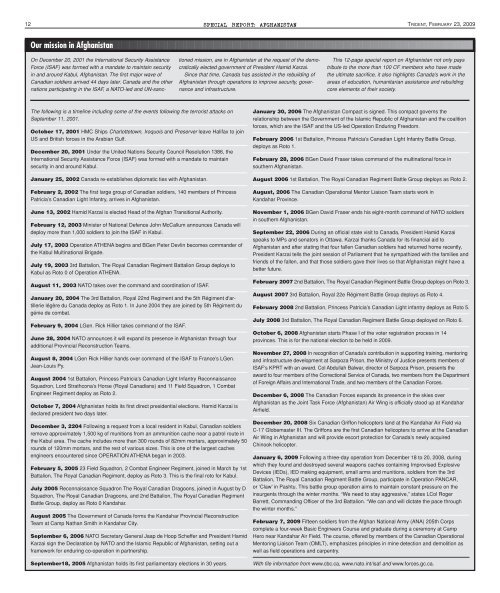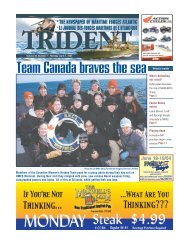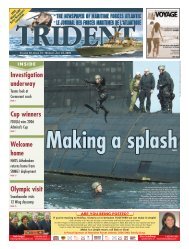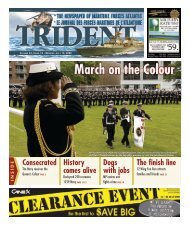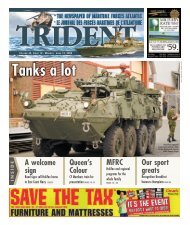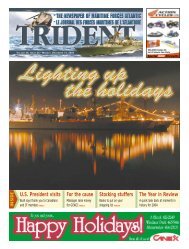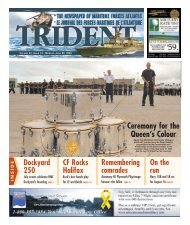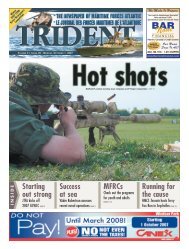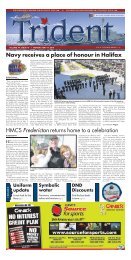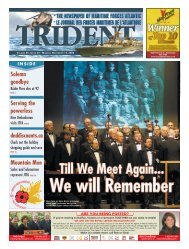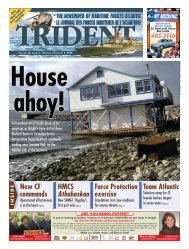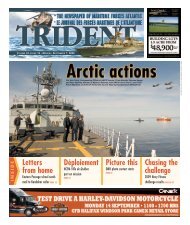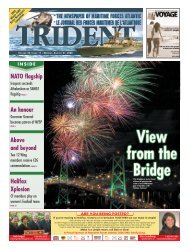February 23, 2009 - Tridentnews.ca
February 23, 2009 - Tridentnews.ca
February 23, 2009 - Tridentnews.ca
- No tags were found...
Create successful ePaper yourself
Turn your PDF publications into a flip-book with our unique Google optimized e-Paper software.
12 SPECIAL REPORT: AFGHANISTAN<br />
TRIDENT, FEBRUARY <strong>23</strong>, <strong>2009</strong><br />
Our mission in Afghanistan<br />
On December 20, 2001 the International Security Assistance<br />
Force (ISAF) was formed with a mandate to maintain security<br />
in and around Kabul, Afghanistan. The first major wave of<br />
Canadian soldiers arrived 44 days later. Canada and the other<br />
nations participating in the ISAF, a NATO-led and UN-sanctioned<br />
mission, are in Afghanistan at the request of the democrati<strong>ca</strong>lly<br />
elected government of President Hamid Karzai.<br />
Since that time, Canada has assisted in the rebuilding of<br />
Afghanistan through operations to improve security, governance<br />
and infrastructure.<br />
This 12-page special report on Afghanistan not only pays<br />
tribute to the more than 100 CF members who have made<br />
the ultimate sacrifice, it also highlights Canada’s work in the<br />
areas of edu<strong>ca</strong>tion, humanitarian assistance and rebuilding<br />
core elements of their society.<br />
The following is a timeline including some of the events following the terrorist attacks on<br />
September 11, 2001.<br />
October 17, 2001 HMC Ships Charlottetown, Iroquois and Preserver leave Halifax to join<br />
US and British forces in the Arabian Gulf.<br />
December 20, 2001 Under the United Nations Security Council Resolution 1386, the<br />
International Security Assistance Force (ISAF) was formed with a mandate to maintain<br />
security in and around Kabul.<br />
January 25, 2002 Canada re-establishes diplomatic ties with Afghanistan.<br />
<strong>February</strong> 2, 2002 The first large group of Canadian soldiers, 140 members of Princess<br />
Patricia’s Canadian Light Infantry, arrives in Afghanistan.<br />
June 13, 2002 Hamid Karzai is elected Head of the Afghan Transitional Authority.<br />
<strong>February</strong> 12, 2003 Minister of National Defence John McCallum announces Canada will<br />
deploy more than 1,000 soldiers to join the ISAF in Kabul.<br />
July 17, 2003 Operation ATHENA begins and BGen Peter Devlin becomes commander of<br />
the Kabul Multinational Brigade.<br />
July 19, 2003 3rd Battalion, The Royal Canadian Regiment Battalion Group deploys to<br />
Kabul as Roto 0 of Operation ATHENA.<br />
August 11, 2003 NATO takes over the command and coordination of ISAF.<br />
January 20, 2004 The 3rd Battalion, Royal 22nd Regiment and the 5th Régiment d'artillerie<br />
légère du Canada deploy as Roto 1. In June 2004 they are joined by 5th Régiment du<br />
génie de combat.<br />
<strong>February</strong> 9, 2004 LGen. Rick Hillier takes command of the ISAF.<br />
June 28, 2004 NATO announces it will expand its presence in Afghanistan through four<br />
additional Provincial Reconstruction Teams.<br />
August 8, 2004 LGen Rick Hillier hands over command of the ISAF to France’s LGen.<br />
Jean-Louis Py.<br />
August 2004 1st Battalion, Princess Patricia’s Canadian Light Infantry Reconnaissance<br />
Squadron, Lord Strathcona’s Horse (Royal Canadians) and 11 Field Squadron, 1 Combat<br />
Engineer Regiment deploy as Roto 2.<br />
October 7, 2004 Afghanistan holds its first direct presidential elections. Hamid Karzai is<br />
declared president two days later.<br />
December 3, 2204 Following a request from a lo<strong>ca</strong>l resident in Kabul, Canadian soldiers<br />
remove approximately 1,500 kg of munitions from an ammunition <strong>ca</strong>che near a patrol route in<br />
the Kabul area. The <strong>ca</strong>che includes more than 300 rounds of 82mm mortars, approximately 50<br />
rounds of 120mm mortars, and the rest of various sizes. This is one of the largest <strong>ca</strong>ches<br />
engineers encountered since OPERATION ATHENA began in 2003.<br />
<strong>February</strong> 5, 2005 <strong>23</strong> Field Squadron, 2 Combat Engineer Regiment, joined in March by 1st<br />
Battalion, The Royal Canadian Regiment, deploy as Roto 3. This is the final roto for Kabul.<br />
July 2005 Reconnaissance Squadron The Royal Canadian Dragoons, joined in August by D<br />
Squadron, The Royal Canadian Dragoons, and 2nd Battalion, The Royal Canadian Regiment<br />
Battle Group, deploy as Roto 0 Kandahar.<br />
August 2005 The Government of Canada forms the Kandahar Provincial Reconstruction<br />
Team at Camp Nathan Smith in Kandahar City.<br />
September 6, 2006 NATO Secretary General Jaap de Hoop Scheffer and President Hamid<br />
Karzai sign the Declaration by NATO and the Islamic Republic of Afghanistan, setting out a<br />
framework for enduring co-operation in partnership.<br />
September18, 2005 Afghanistan holds its first parliamentary elections in 30 years.<br />
January 30, 2006 The Afghanistan Compact is signed. This compact governs the<br />
relationship between the Government of the Islamic Republic of Afghanistan and the coalition<br />
forces, which are the ISAF and the US-led Operation Enduring Freedom.<br />
<strong>February</strong> 2006 1st Battalion, Princess Patricia’s Canadian Light Infantry Battle Group,<br />
deploys as Roto 1.<br />
<strong>February</strong> 28, 2006 BGen David Fraser takes command of the multinational force in<br />
southern Afghanistan.<br />
August 2006 1st Battalion, The Royal Canadian Regiment Battle Group deploys as Roto 2.<br />
August, 2006 The Canadian Operational Mentor Liaison Team starts work in<br />
Kandahar Province.<br />
November 1, 2006 BGen David Fraser ends his eight-month command of NATO soldiers<br />
in southern Afghanistan.<br />
September 22, 2006 During an official state visit to Canada, President Hamid Karzai<br />
speaks to MPs and senators in Ottawa. Karzai thanks Canada for its financial aid to<br />
Afghanistan and after stating that four fallen Canadian soldiers had returned home recently,<br />
President Karzai tells the joint session of Parliament that he sympathized with the families and<br />
friends of the fallen, and that those soldiers gave their lives so that Afghanistan might have a<br />
better future.<br />
<strong>February</strong> 2007 2nd Battalion, The Royal Canadian Regiment Battle Group deploys on Roto 3.<br />
August 2007 3rd Battalion, Royal 22e Régiment Battle Group deploys as Roto 4.<br />
<strong>February</strong> 2008 2nd Battalion, Princess Patricia’s Canadian Light infantry deploys as Roto 5.<br />
July 2008 3rd Battalion, The Royal Canadian Regiment Battle Group deployed on Roto 6.<br />
October 6, 2008 Afghanistan starts Phase I of the voter registration process in 14<br />
provinces. This is for the national election to be held in <strong>2009</strong>.<br />
November 27, 2008 In recognition of Canada’s contribution in supporting training, mentoring<br />
and infrastructure development at Sarpoza Prison, the Ministry of Justice presents members of<br />
ISAF’s KPRT with an award. Col Abdullah Balwar, director of Sarpoza Prison, presents the<br />
award to four members of the Correctional Service of Canada, two members from the Department<br />
of Foreign Affairs and International Trade, and two members of the Canadian Forces.<br />
December 6, 2008 The Canadian Forces expands its presence in the skies over<br />
Afghanistan as the Joint Task Force (Afghanistan) Air Wing is officially stood up at Kandahar<br />
Airfield.<br />
December 20, 2008 Six Canadian Griffon helicopters land at the Kandahar Air Field via<br />
C-17 Globemaster III. The Griffons are the first Canadian helicopters to arrive at the Canadian<br />
Air Wing in Afghanistan and will provide escort protection for Canada’s newly acquired<br />
Chinook helicopter.<br />
January 6, <strong>2009</strong> Following a three-day operation from December 18 to 20, 2008, during<br />
which they found and destroyed several weapons <strong>ca</strong>ches containing Improvised Explosive<br />
Devices (IEDs), IED making equipment, small arms and munitions, soldiers from the 3rd<br />
Battalion, The Royal Canadian Regiment Battle Group, participate in Operation PANCAR,<br />
or ‘Claw’ in Pashtu. This battle group operation aims to maintain constant pressure on the<br />
insurgents through the winter months. “We need to stay aggressive,” states LCol Roger<br />
Barrett, Commanding Officer of the 3rd Battalion. “We <strong>ca</strong>n and will dictate the pace through<br />
the winter months.”<br />
<strong>February</strong> 7, <strong>2009</strong> Fifteen soldiers from the Afghan National Army (ANA) 205th Corps<br />
complete a four-week Basic Engineers Course and graduate during a ceremony at Camp<br />
Hero near Kandahar Air Field. The course, offered by members of the Canadian Operational<br />
Mentoring Liaison Team (OMLT), emphasizes principles in mine detection and demolition as<br />
well as field operations and <strong>ca</strong>rpentry.<br />
With file information from www.cbc.<strong>ca</strong>, www.nato.int/isaf and www.forces.gc.<strong>ca</strong>.


